

Queer Places:
The Art Students League of New York, 215 W 57th St, 10019
102 W 76th St, New York, NY 10023
Bryant Park Studios, 80 W 40th St, New York, NY 10018
Alwyn Court,
180 W 58th St, New York, NY 10019
 Florine
Stettheimer (August 19, 1871 – May 11, 1944) was an American modernist
painter, feminist, theatrical designer, poet, and salonnière. A unique aspects of the Stettheimer salon was that their numerous gay,
bisexual, and lesbian friends and acquaintances did not need to disguise their
sexual orientation at the gatherings as they did at other salons (such as the
Arensberg Salon), despite the fact that non-heterosexual relationships
were illegal in New York at the time.[22]
Stettheimer often previewed her newest paintings to her friends at her salons,
as in her painting Soirée (1917–19). Stettheimer's older sister Carrie
created special cocktails and dishes, such as feather soup, for the salons.[23]
During the summers, the Stettheimers often held day-long, salon-like parties
for friends at rented summer houses. Stettheimer painted a number of these
gatherings of her family members and friends enjoying outdoor festivities,
including Sunday Afternoon in the Country (1917).[24]
Several of the sisters’ closest friends, including
Charles Demuth,
Marsden Hartley,
Henry McBride,
Virgil Thomson, and Baron
Adolph de Meyer (married to a lesbian,
Olga Carracciolo) were homosexual;
Carl Van Vechten,
Cecil Beaton, and
Georgia O’Keeffe were bisexual;
Natalie Barney and
Romaine Brooks were lesbians; and
Alfred Stieglitz,
Marcel Duchamp,
Gaston Lachaise, Marie Sterner, and
Leo Stein were heterosexual. This open, natural mix of friends with different sexual preferences continued when Stettheimer held salons in her studio in the Beaux Arts building in midtown Manhattan, although later in life she also had parties where most of the guests were strong feminist women.
Florine
Stettheimer (August 19, 1871 – May 11, 1944) was an American modernist
painter, feminist, theatrical designer, poet, and salonnière. A unique aspects of the Stettheimer salon was that their numerous gay,
bisexual, and lesbian friends and acquaintances did not need to disguise their
sexual orientation at the gatherings as they did at other salons (such as the
Arensberg Salon), despite the fact that non-heterosexual relationships
were illegal in New York at the time.[22]
Stettheimer often previewed her newest paintings to her friends at her salons,
as in her painting Soirée (1917–19). Stettheimer's older sister Carrie
created special cocktails and dishes, such as feather soup, for the salons.[23]
During the summers, the Stettheimers often held day-long, salon-like parties
for friends at rented summer houses. Stettheimer painted a number of these
gatherings of her family members and friends enjoying outdoor festivities,
including Sunday Afternoon in the Country (1917).[24]
Several of the sisters’ closest friends, including
Charles Demuth,
Marsden Hartley,
Henry McBride,
Virgil Thomson, and Baron
Adolph de Meyer (married to a lesbian,
Olga Carracciolo) were homosexual;
Carl Van Vechten,
Cecil Beaton, and
Georgia O’Keeffe were bisexual;
Natalie Barney and
Romaine Brooks were lesbians; and
Alfred Stieglitz,
Marcel Duchamp,
Gaston Lachaise, Marie Sterner, and
Leo Stein were heterosexual. This open, natural mix of friends with different sexual preferences continued when Stettheimer held salons in her studio in the Beaux Arts building in midtown Manhattan, although later in life she also had parties where most of the guests were strong feminist women.
Stettheimer developed a feminine, theatrical painting style based on the avant-garde personalities and experiences of newly modernist New York City. She painted the first feminist nude self-portrait, executed paintings depicting controversial issues of race and sexual preference, depicted the leisure activities and parties of her family and friends, and, with her sisters, hosted a salon renowned for attracting influential members of the avant-garde.[1] In the mid-1930s, Stettheimer achieved international acclaim for her stage designs and costumes (using the innovative material cellophane) for Gertrude Stein and Virgil Thomson's avant-garde opera, Four Saints in Three Acts. She is best known for her four monumental works illustrating what she considered to be New York City's "Cathedrals": Broadway, Wall Street, Fifth Avenue, and art museums.
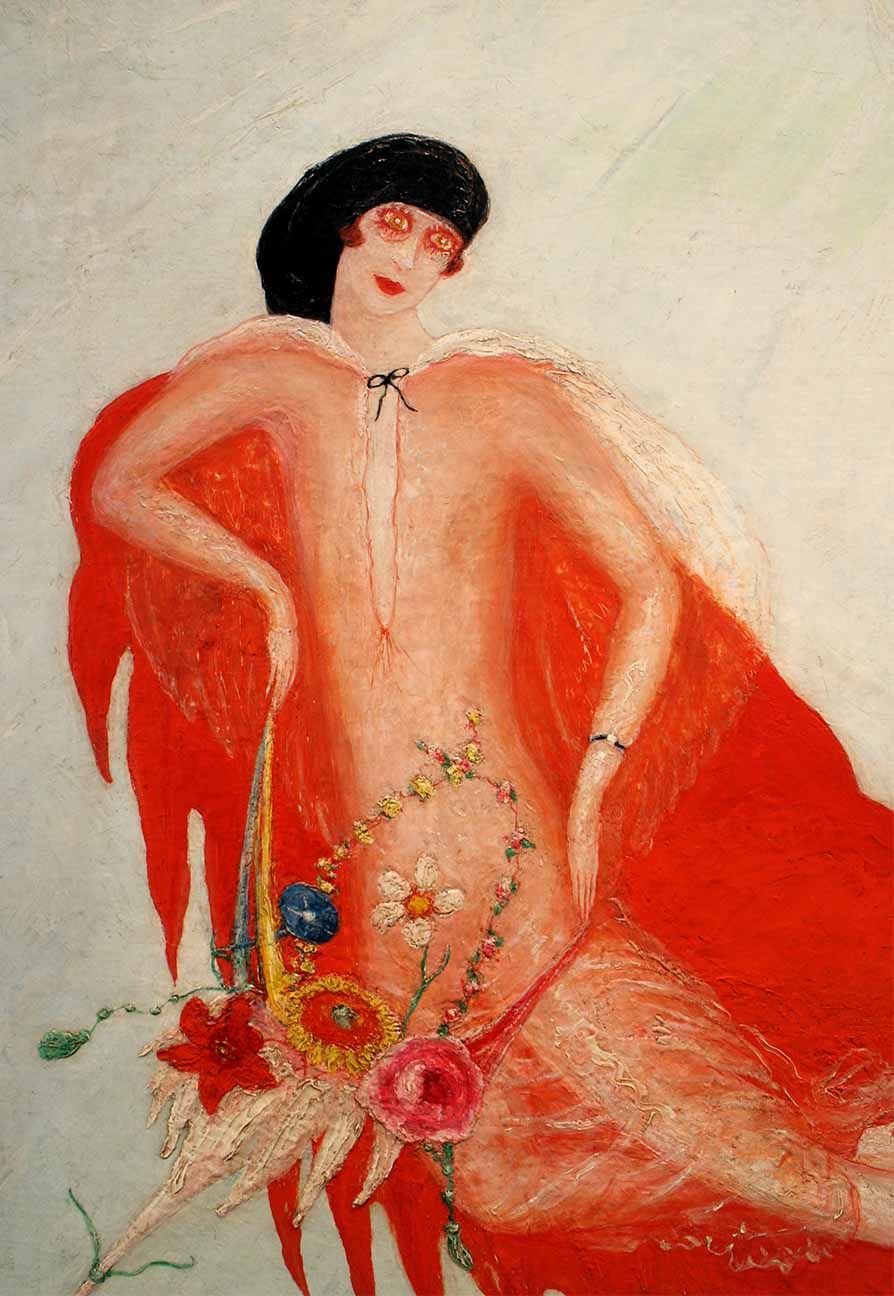
Florine Stettheimer, Portrait of Myself, 1923
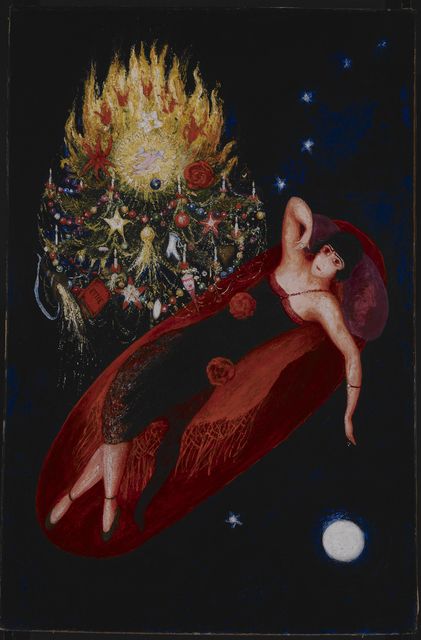
Florine Stettheimer, Portrait of My Sister, Ettie Stettheimer, 1923
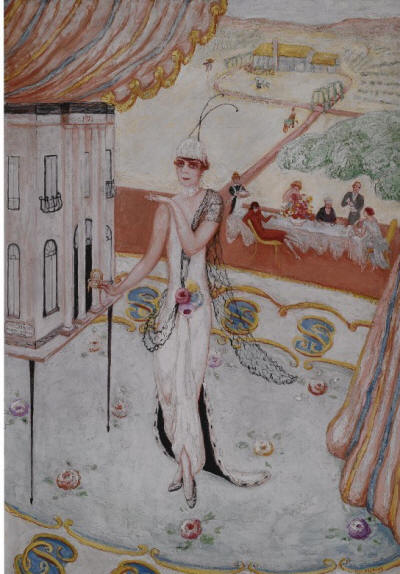
Florine Stettheimer, Portrait of My Sister, Carrie W. Stettheimer, 1923
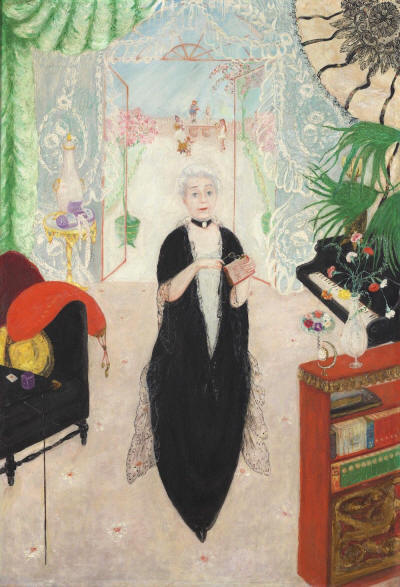
Florine Stettheimer, Portrait of My Mother, 1925
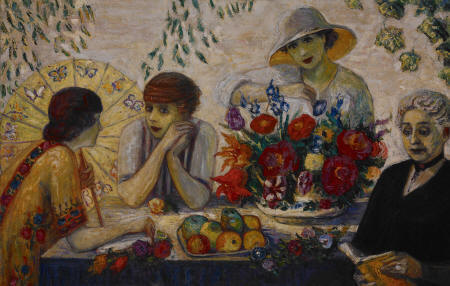
Florine Stettheimer, Family Portrait I, 1915. Art Properties, Avery Architectural and Fine Arts Library, Columbia University in the City of New York, New York. Gift of the Estate of Ettie Stettheimer, 1967
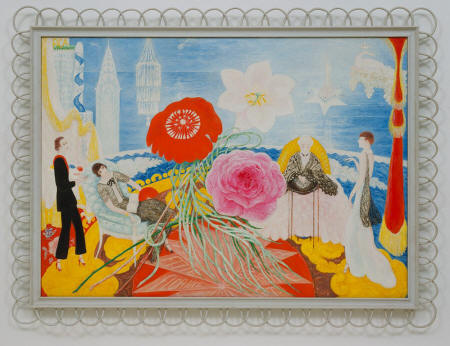
Florine Stettheimer, Family Portrait II, 1933. Museum of Modern Art, New York. Gift of Miss Ettie Stettheimer, 1956. Image provided by The Museum of Modern Art / SCALA / Art Resource, New York
Florine, Carrie, and Ettie Stettheimer
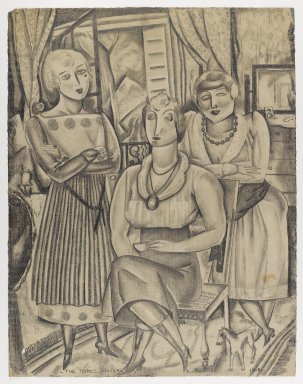
Louis (George Louis Robert) Bouché (American, 1896-1969). The Three Sisters, 1918. Graphite on cream, moderately thick, moderately textured laid paper, sheet: 24 3/16 x 18 7/8 in. (61.4 x 47.9 cm). Brooklyn Museum, Gift of Ettie Stettheimer, 45.121 (Photo: Brooklyn Museum, 45.121_IMLS_PS4.jpg)
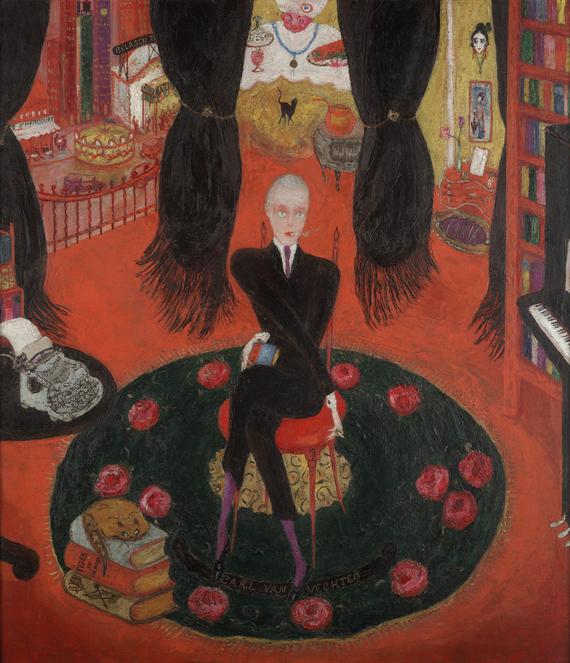
Carl Van Vechten by Florine Stettheimer
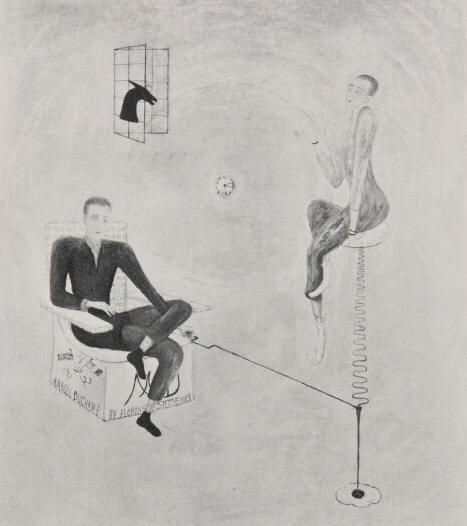
Marcel Duchamp and Rosa Selavy by Florine Stettheimer

Florine Stettheimer (1871-1944). Portrait of Louis Bouché, 1923. Oil on canvas, 20 x 18”. Heckscher Museum, Gift the Baker/Pisano Collection, 2001.9.235
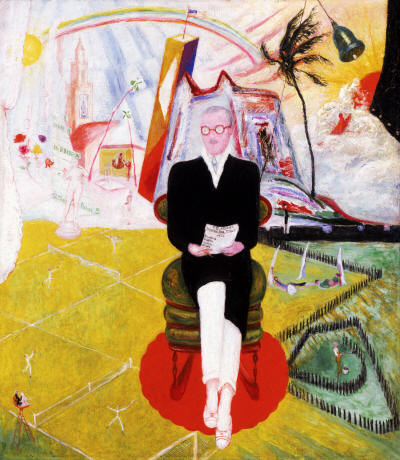
Henry McBride by Florine Stettheimer
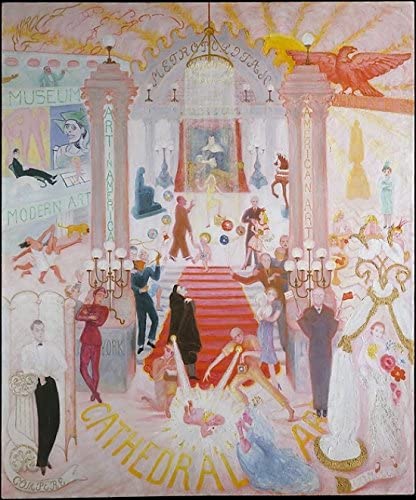
Cathedrals of Art by Florine Stettheimer
During her lifetime, Stettheimer exhibited her paintings at more than 40 important museum exhibitions and salons in New York and Paris. In 1938, when the curator of the Museum of Modern Art sent the first exhibition of American art to Europe, Stettheimer and Georgia O'Keeffe were the only women whose work was included.[2] Following her death in 1944, her friend Marcel Duchamp curated a retrospective exhibition of her work at the Museum of Modern Art in 1946. It was the museum's first retrospective exhibition of work by a woman artist. After her death, Stettheimer's paintings were donated to major museums throughout the United States. In addition to her many paintings and costume and set designs, Stettheimer designed unique frames for her paintings and matching furniture, and wrote humorous, often biting poetry. A book of her poetry, Crystal Flowers, was published privately and posthumously by her sister Ettie Stettheimer in 1949.[3]
Florine Stettheimer was born in Rochester, New York, on August 19, 1871.[4][5] Her mother, Rosetta Walter, was one of nine daughters from a wealthy German-Jewish family in New York.[6] Stettheimer's father, Joseph, had five children with Rosetta Walter but deserted his family for Australia. Stettheimer grew up in between New York City and Europe, in a matriarchal family. By the time Stettheimer was ten, Rosetta and her five children spent part of every year in Europe.[7] By the early 1890s, two of Rosetta's children, Stella and Walter, had married and left the household. Caroline (Carrie), the next eldest, Florine, and Henrietta (Ettie), the youngest, formed a close bond with their mother that lasted until her death in 1935. The three sisters were sometimes known as the "Stetties".[8][9]
Stettheimer demonstrated artistic talent as a child. From 1881 to 1886, when she was ten to fifteen years old, she was enrolled in Stuttgart's Priesersches Institut, a girls' boarding school, where she took private art instruction with the director, Sophie von Prieser. The Stettheimers lived in Berlin from 1887 to 1889, where Stettheimer continued taking private drawing lessons.[7] Regularly traveling through Europe with her mother, Carrie, and Ettie, Stettheimer taught herself art history by visiting museums and art galleries in Italy, France, Spain, and Germany. She studied the Old Masters, and critiqued their work in her diaries. She continued to take private art lessons in media such as casein.[10][11]
In 1892, Stettheimer enrolled in a four-year program at the Art Students League in New York, a school modeled on the private art schools of Paris.[12] While in Germany, she had learned the style of German academic painting. At the Art Students League, she studied with teachers such as Kenyon Cox, Harry Siddons Mowbray, and Carol Beckwith, who had studied French academic painting in Paris.[11][13] By graduation, she had mastered painting realistic, traditional, academic portraiture and nudes in both of the primary European styles.[14]
Returning to Europe, in addition to visiting museum collections, Stettheimer also visited contemporary salon exhibitions and artists' studios and saw the work of the Cubists, Cézanne, Manet, van Gogh, Morisot, and Matisse years before the Armory Show, the first large exhibition of modern art in America. With varying success, she tried her hand at a variety of media and styles from Symbolism and Fauvism to Pointillism, resulting in a series of works that are reminiscent of Matisse's Luxe, Calme et Volupté.[15][16]
The performances of Serge Diaghilev's Ballets Russes in Paris in 1912 were a key influence on Stettheimer's painting. Captivated with the staging and choreography of the Ballets Russes, she created the libretto, costumes, and sets for an opera of her own: Orphée des Quat'z Arts. She based the libretto on the annual art students' Bal des Quat'z'Arts. The resulting maquettes, with their costumed characters made from intricately sewn and beaded materials, display theatrical, active, dance-like movements and individualized personalities that prefigure her mature paintings that emerged in 1917. While working on Orphée, she still painted conventional landscapes and portraits.[17]
Many of the female figures wear a newly invented transparent material; cellophane. The use of cellophane became the hallmark of her interior design and, two decades later, the stage sets for the opera Four Saints in Three Acts.[18] Orphée des Quat'z Arts has never been staged. The libretto was published in its entirety in the 2010 reissue of Crystal Flowers. Literary historian Irene Gammel and writer Suzanne Zelazo, in their introduction to that volume, describe the ballet opera as: "merging bohemian carnivalesque with the charms of 'a blonde Vicomte'."[19]
In 1914, the Stettheimers were stranded in Bern, Switzerland, by the outbreak of World War I, and eventually boarded a ship for New York. Stettheimer decided to reject her traditional academic training and create a new painting style, capturing the immediate, expressive emotions she felt on seeing the sights, sounds, and people of 20th-century New York City.[20] The four Stettheimer women moved into an apartment on West 76th Street in Manhattan, where they began holding salons, inviting recent expatriate artists such as Marcel Duchamp, Albert Gleizes, and Francis Picabia, as well as members of Alfred Stieglitz's circle, such as Marsden Hartley and Georgia O'Keeffe, and other musicians, writers, poets, dancers, and members of New York's avant-garde.[21]
During her lifetime Stettheimer had only one solo exhibition, at Knoedler in 1916.[25] Her friends encouraged her to exhibit her work publicly, but finding a suitable venue was complicated by Stettheimer's insistence that the gallery be redecorated to resemble her boudoir. Albert Sterner's wife, Marie Sterner, who worked at Knoedler, acted as an intermediary between the artist and the gallerist.[26] The show consisted of a number of new works, derivative of Matisse, painted with bright, pure colors, thick impasto, and heavy contours.[a][27] When nothing sold, she was, as her friend, the art critic Henry McBride, noted, "vaguely dissatisfied."[28] In the year that followed, Stettheimer's style evolved to an idiosyncratic visual language, rejecting both traditional formalism and modernist abstraction.[29] Stettheimer transformed her painting style by returning to the miniaturized, theatrical, colorful influence of her designs for Orphee des Quat'z Arts. In Stettheimer's mature work, each canvas is arranged like a stage, filled with easily identifiable family members, friends, and acquaintances. Her use of what Duchamp called multiplication virtuelle, continuous narrative, is both purposefully naive and sophisticated; it has roots both in folk art and the ideas of Henri Bergson and Marcel Proust about time and memory.[30][31]
In all her paintings but the portraits, Stettheimer filled her painting with bright, often unmixed, primary colors against a flat white background, and many, small, highly detailed, humorous touches. Using various media, Stettheimer keyed her compositions using primary colors as accents, often symbolically. Among the many distinctive features of her paintings is the biting humor evident in many compositions' small narrative details, like the small altar boy trying to peek under the bride's gown in Cathedrals of Fifth Avenue (1931). Stettheimer also filled her compositions with visual performances of individually recognizable figures, arranged around actual prominent locations and detailed, well-known architecture.
The 1920s were Stettheimer's most prolific period. She painted a number of individual portraits of male friends and herself and family. Like her literary contemporaries Proust and Gertrude Stein, instead of trying to reproduce what the sitter looked like, Stettheimer's portraits reveal their sitter's personality through illustrating a mixture of their habits, vocations, accomplishments, and contexts. In her Portrait of Marcel Duchamp and Rrose Sélavy, for example, she included images of a number of his "readymades," as well as his feminine alter ego, Rrose Sélavy. She also painted individual portraits of her sisters and her mother, and a self-portrait in which she is wearing an artist's beret, transparent cellophane-wrapped sheath, and red-winged cape and is floating upward towards the sun.[32]
Stettheimer also painted several monumental works dealing with controversial subjects, such as Asbury Park South, which shows African-Americans enjoying a well-known, segregated New Jersey beach. The painting is remarkable in that it is the earliest work by a white American artist to paint black figures with the same non-caricatured features as the Caucasian figures. In Lake Placid (1919),[33] Stettheimer painted herself and friends of various religions (including Jews and Catholics) enjoying a day at Lake Placid, a site know for its institutionalized antisemitism.[34] Recalling the premiere of a controversial Ballets Russes performance Stettheimer saw in Paris in 1912, in Music, Stettheimer painted herself asleep, dreaming of the dancer Nijinsky, en pointe, with the body of both a man and a woman.[22]
During the 1930s, Stettheimer continued to paint large works, some of which were increasingly introspective and returned to her familial subject matter and locations. She continued to paint a floral still-life each year on her birthday that she referred to as an "eyegay," a play on the word "nosegay" (small bouquet).[35] She spent much of her time during this decade on her designs for the opera Four Saints in Three Acts and two of her Cathedral paintings.
Beginning in 1929, and continuing until the mid-1940s, Stettheimer painted four monumental works she titled Cathedral paintings. She commemorated in these what she considered the main "secular shrines" of New York City: the new theater and movie districts of Times Square and Broadway; Wall Street as the center of finance and politics; Fifth Avenue's upper-class stores and society; and the elitism and in-fighting among New York's three major art museums, the Museum of Modern Art, the Metropolitan Museum of Art, and the Whitney Museum of American Art. She continued to work on The Cathedrals of Art until a few weeks before she passed away. It remains unfinished.[36]
In 1934, Four Saints in Three Acts, the first avant-garde opera in America, opened to sold-out audiences in Hartford, Connecticut. The libretto was written by Gertrude Stein and the music by Virgil Thomson. Stettheimer designed the stage and the costumes. Thomson invited Stettheimer to design the opera when he saw her paintings in their custom frames, her matching furniture designs, and the studio's cellophane curtains. In preparation for the production, Stettheimer made dolls with fully sewn costumes for each of the characters.[37] She created designs for each scene setting in small shoe boxes. Stettheimer covered the entire back of the opera stage with layers of cellophane, created palm trees with cellophane and feathers, and, for the stage sets, copied her own furniture. The opera received mixed reviews, but Stettheimer's costumes and sets won universal acclaim.[38][39]
During her twenties and thirties, Stettheimer engaged in flirtations and romantic relationships, and her paintings, diaries, and poems reveal her admiration for the male anatomy. However, they also demonstrate that she adamantly opposed the idea of marriage, believing like many feminists that it constricted women's freedom and interfered with creativity.[3]
She wore white pantaloons, which at the time were only worn by feminists and suffragettes and also provided freedom for working on larger canvases. During her years in Europe, Stettheimer and her sisters sought out theatrical productions that featured feminist themes and women performers.[22] Among the flyers in the family scrapbooks is a copy of the proceedings of the First International Feminist Congress held in Paris in 1896.
In 1915, at the age of 45, Stettheimer painted a naked, over life-size self-portrait, A Model (Nude Self-Portrait). Combining elements of past controversial nudes including Manet's painting of the prostitute Olympia and Goya's Nude Maja, Stettheimer's Nude Self-Portrait is only the second known nude self-portrait by a woman that exists.[b] Holding a flower bouquet above her blatantly painted pubic hair, Stettheimer's humorous, mocking expression in the portrait markedly contrasts with traditional paintings of nudes, making it the first openly feminist nude painted from a woman's point of view, rather than for a man's pleasure.[1][
The artist painted several works of unusual, female-oriented contexts such as her monumental 1921 work Spring Sale at Bendel's, in which she humorously captured wealthy women of varying body shapes trying on clothing in an expensive department store; or Natatorium Undine, which portrays nude women riding on floats or swimming on half-oyster shells. On the right, in a sexual reversal from traditional subject matter, a group of women dances around a handsome male exercise instructor whom they admire for his physical appearance.[1]
Stettheimer wrote her poems on little scraps of paper. They were gathered and privately published by her sister Ettie. Some of her poems are written in nursery style, some offer witty social critiques, and others present satiric portraits of fellow modernists, such as Gertrude Stein ("Gertie") and Marcel Duchamp ("Duche"). Her poems show an awareness of contemporary consumer culture and offer an acerbic indictment of marriage, as her poem dedicated to Marie Sterner, a New York gallerist who curated her exhibition at Knoedler's, "who intended to be a musician/ but Albert married her."[40] Stettheimer's poems were posthumously assembled in Crystal Flowers, collected and edited by her sister Ettie and privately published in a limited edition in 1949 that Ettie sent to her family and friends.[41]
In 2010 Gammel and Zelazo re-issued Stettheimer's poems and her early ballet libretto, stating that in Stettheimer's "hands and on her tongue, the surface for Stettheimer is depth."[42] They continue, "A close look at the poems reveals equally glittering surfaces and glossy protective veneers" that may be found in the paintings. Gammel and Zelazo see in Stettheimer's work a "grammar of artifice ... designed to cultivate an acute awareness of aesthetic perspective in the reader," as well as "an aesthetics of cellophane," a decidedly modern material she used to decorate her stages and her bedroom, occasionally mixing it with old-fashioned laces.[43]
On May 11, 1944, Stettheimer died of cancer in New York Hospital. She was attended daily by her sisters Ettie and Carrie (the latter died unexpectedly a few weeks later) and her lawyer Joseph Solomon. Unlike the other members of her family who were buried in the family plot, Stettheimer asked to be cremated, and, several years later, her ashes were scattered during a boat trip on the Hudson River by Ettie and Solomon. For many years, Stettheimer had expressed her wishes that all her work be given, as a collection, to a museum. However, realizing that it might prove too difficult to find one museum to take the entire collection, she revised her will, asking that her sister's "follow her wishes" that her works not be sold, but be donated to museums around the country. Ettie left this task to Solomon and Stettheimer's friends, who donated Stettheimer's paintings to most major art museums in the United States, including giving the Cathedral paintings to the Metropolitan Museum of Art.[44]
On hearing of her passing, Duchamp wrote Ettie from France and asked if he could organize a retrospective of Stettheimer's paintings. The exhibition, the first full retrospective of a woman artist organized by the Museum of Modern Art, included a catalog essay written by Stettheimer's friend, art critic Henry McBride.[45] Following its run in New York, the Stettheimer retrospective traveled to the San Francisco Legion of Honor Museum and the Arts Club of Chicago.[46]
Throughout her life, gallerists in New York, including Julien Levy and Alfred Stieglitz, asked Stettheimer to join their galleries. Although she did exhibit at a number of retail galleries and was often asked to sell her work, she priced each painting at the equivalent of hundreds of thousands of dollars, so no one could afford them. As McBride noted, "She used to smile and say that she liked her pictures herself and preferred to keep them. At the same time, she did lend to public exhibitions."[28] Beginning in 1919, Stettheimer submitted or was invited to exhibit paintings in almost every important exhibition of contemporary art. These included the first Whitney Biennial, several of the earliest group exhibitions and the Museum of Modern Art, the Carnegie International exhibitions, and the Salon d'Automne in Paris. In all, she exhibited in over forty-six exhibitions, and her large, colorful works were usually singled out by art critics for praise. By the 1930s, she was second to Georgia O'Keeffe as the best-known woman artist in New York. In a Harper's Bazaar article after her death, the writer Carl Van Vechten stated that Stettheimer "was both the historian and the critic of her period and she goes a long way toward telling us how some of New York lived in those strange years after the First World War, telling us in brilliant colors and assured designs, telling us in painting that has few rivals in her day or ours."[47]
Following her death in the late 1940s, when Stettheimer's works were donated to art museums, the taste in art had moved to abstract expressionism, and her paintings were frequently not displayed. In addition, because her paintings were not sold at art galleries or at auction, they received no publicity and so her name and work were not as well known. Author Parker Tyler's biography, Florine Stettheimer: A Life in Art, was released in 1963.[48][22] In the 1970s Stettheimer's work was revived by feminist art historians including, most prominently, Linda Nochlin.[29] Stettheimer went through another revival in 1995 with a retrospective exhibition of her work at the Whitney Museum of American Art[46] and the publication of another biography, The Life and Art of Florine Stettheimer.[49][50] From this point on, her work influenced a number of contemporary women and gay artists, drawn to her female gaze and decorative, theatrical style. Beginning in 2015 with the first retrospective of Stettheimer's work in Europe at the Lenbachhaus in Munich, Stettheimer's work has been included in numerous exhibitions in the United States, and her significance as an early feminist artist and her widespread influence on contemporary artists is more fully recognized. Andrew Russeth, the executive editor of ARTnews, stated that Stettheimer's paintings "elegantly make the case that she is one of the greatest artists of the 20th century and could serve as a useful model for those of the 21st."[51]
During her lifetime, Stettheimer's work was specifically mentioned and cited favorably by critics reviewing the many exhibitions in which it was shown, as well as by the writer/photographer Carl Van Vechten and the painter Marsden Hartley. Van Vechten, contrasting her work to that of Charles Demuth, wrote that Stettheimer's work possessed a very modern quality: "At the risk of being misunderstood, I must call this quality jazz."[52] Hartley praised her "delicate satire and iridescent wit."[53] In their essay, "Wrapped in Cellophane: Florine Stettheimer's Visual Poetics," Irene Gammel and Suzanne Zelazo review the various positions voiced by scholars and biographers regarding Stettheimer's unique modernist sensibility, whose whimsy seems very different from mainstream modernists. They write:
Unapologetically domestic and über-feminine, Stettheimer's work has been variously described as 'faux naïf', reveling in simplified shapes and Fauve-like colors (Tatham); as 'rococo subversive', embracing a camp sensibility (Nochlin); and as 'temporal modernism' influenced by Bergsonian concepts of time as heterogeneous durée, aligning Stettheimer with Marcel Proust and other literary modernists (Bloemink).[43]
Representing an international style of modernism that integrates various art forms, Stettheimer's paintings, like her poems, are sensorily as well as sensually charged. Because she refused to affiliate herself with a single, well-known art gallery, such as the Stieglitz "Group", or with a specific style such as Dada or abstraction, Stettheimer's work was always received and reviewed as uniquely her own.[54] Her unique, feminine style and consciously female gaze set her work directly against the critical tastes of the male-dominated Abstract Expressionism and Minimalism of the 1960s and 1970s.[55]
Stettheimer is also connected with Hannah Hoch, Helen Clay Frick, Sarah Hewitt and Eleanor Hewitt.
My published books: